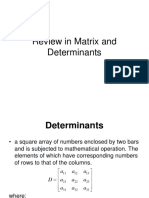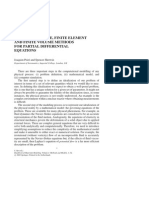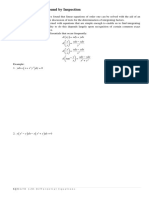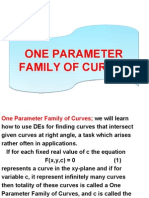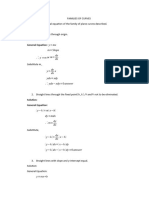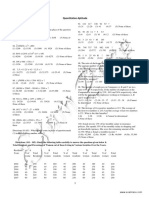Module 7 - Derivatives of Expo Functions
Uploaded by
Lyka Soriano MopasModule 7 - Derivatives of Expo Functions
Uploaded by
Lyka Soriano MopasDIFFERENTIAL CALCULUS
MODULE 7
DIFFERENTIATION OF
EXPONENTIAL FUNCTIONS
Laws of Exponent
The laws of exponent are listed below for your quick reference. Let a, b, m, and n
be non-zero numbers or quantity.
I. am ∙ an = a m + n
am
II. = am – n
an
III. am ∙ bm = (ab)m
IV. (am)n = amn
V. a0 = 1
1
VI. a-n =
an
Radicals
Radicals abide by the laws of exponent since they can be expressed exponentially.
√𝑎𝑚 where n is the index of the radical (always positive) and am is the radicand
𝑛
√am = am/n “nth root of am”
n
I.
√an = an/n = 1
n
II.
n n n
III. √a ∙ √b = √ab
n
√a n a
IV. n = √
√b b
Differential Calculus | Derivatives of Exponential Functions | Page 1 of 7
Derivatives of Exponential Functions
Let u and v be a differentiable function of x and a ≠ 0, 1.
d du
I. ( au ) = au ∙ ln a ∙
dx dx
d du
II. ( eu ) = eu ∙
dx dx
d d
III. ( uv ) = uv ∙ ( v ln u )
dx dx
Proof of I and II:
For au, let y = au
ln y = ln au Take ln of both sides.
ln y = u ln a
d d
( ln y ) = ( u ln a ) Differentiate both sides with respect to x.
dx dx
1 d du
∙ (y) = ln a ∙ ln a is a constant.
y dx dx
dy du
= y ln a ∙ Replace y by au, since given.
dx dx
d du
∴ ( au ) = au ln a ∙
dx dx
For eu, simply replace a by e. Then,
d du du du
∴ ( eu ) = eu ln e ∙ = eu ∙ 1 ∙ = eu ∙
dx dx dx dx
Remarks on the three formulas:
All of the three formulas copy the given exponential functions.
Differential Calculus | Derivatives of Exponential Functions | Page 2 of 7
EXAMPLE 1. Find y’ of y = 53x – 2
Here a = 5 and u = 3x – 2
dy d
∴ = ( 53x – 2 )
dx dx
d
= 53x – 2 ln 5 ∙ ( 3x – 2 )
dx
= 53x – 2 ln 5 ∙ 3 Note that 5 is “protected” inside ln.
= 53x – 2 ( 3 ln 5 ) Be careful! Baka mamaya ln 15 sagot niyo dyan.
or 53x – 2 ln 125 Ans.
2 + 2x
EXAMPLE 2. Find y’ of y = 4x
2 + 2x d
∴ y’ = 4x ln 4 ∙ ( x2 + 2x )
dx
2
= 4x + 2x
ln 4 ∙ ( 2x + 2 ) Grouping symbols!
2+
= 4x 2x
( 2x + 2 ) ln 4 Ans.
You can still express the answer into different equivalent forms by applying laws of
exponent and properties of logarithm, but be careful and be sure you do not disobey any
mathematical rule and law.
2 +2x)
= 22(x ∙ 2 ( x + 1 ) ∙ 2 ln 2
2 + 4x + 1 + 1
= 22x ( x + 1 ) ln 2
2 + 4x
= 22x +2
( x + 1 ) ln 2 Ans.
2 + 2x
or = 22(x + 1)
( x + 1 ) ln 2
2 + 2x
= 4x +1
( x + 1 ) ln 2 Ans.
Differential Calculus | Derivatives of Exponential Functions | Page 3 of 7
EXAMPLE 3. Find y’ of y = (5b)sin x Note: 5 is included in the base. This is not the
same as 5bsin x
d
∴ y’ = (5b)sin x
dx
d
= (5b)sin x ln 5b ∙ ( sin x )
dx
d
= (5b)sin x ln 5b ∙ cos x ∙ (x)
dx
= (5b)sin x cos x (ln 5b) Ans.
EXAMPLE 4. Find the first derivative of y = ecsc x
d
∴ y’ = ( ecsc x )
dx
d
= ecsc x ∙ ( csc x )
dx
= ecsc x ∙ (-csc x cot x)
= - ecsc xcsc x cot x Ans.
EXAMPLE 5. Find the first derivative of y = xex. This takes the form u ∙ v
d
∴ y’ = ( xex )
dx
d d
=x∙ ( ex ) + ex ∙ (x)
dx dx
= xex + ex
= ex ( x + 1 ) Ans.
Differential Calculus | Derivatives of Exponential Functions | Page 4 of 7
ex + e-x
EXAMPLE 6. Find y’ of y =
2
ex + e-x 1
y= = ( ex + e-x )
2 2
1 d d
∴ y’ = [ ( ex ) + ( e-x ) ] Grouping symbols!
2 dx dx
1 d
= [ ex + e-x ∙ ( -x ) ]
2 dx
ex − e-x
= Ans.
2
EXAMPLE 7. Find y’ of y = xx. This one takes the form uv
d
∴ y’ = ( xx )
dx
d
= xx ∙ ( x ln x )
dx
d d
= xx [ x ∙ ( ln x ) + ln x ∙ (x)] → Product Rule
dx dx
1 dx
= xx [ x ∙ ∙ + ln x ]
x dx
= xx ( 1 + ln x ) Ans.
EXAMPLE 8. Find y’ of xy = exy
d d
( xy ) = ( exy )
dx dx
d
xy' + y = exy ( xy )
dx
xy' + y = exy ( xy' + y ) Warning! Do not cancel out xy’ + y
xy' + y = exyxy' + exyy
Differential Calculus | Derivatives of Exponential Functions | Page 5 of 7
xy' – exyxy' = exyy – y
y' ( x – exyx ) = y ( exy – 1 )
y ( exy −1 )
y' =
x( 1 − exy )
y ( exy − 1 )
=
x [-1( exy −1 )]
y
=– Ans.
x
EXAMPLE 9. Use the chain rule to find y’, given y = 5au and u = ln sin x.
dy d
∴ = ( 5au )
du du
d
=5∙ ( au )
du
= 5au ln a
du d
∴ = ( ln sin x )
dx dx
1 d
= ∙ ( sin x )
sin x dx
1
= ∙ cos x
sin x
= cot x
dy du
∴ y’ = ∙
du dx
= 5au ln a ∙ cot x
= 5aln sin x (cot x) ln a Ans.
Note: You must group the terms properly so that it will be understood kung ano ang nasa
loob LANG ng ln, ng cotangent, ng arcsine, and other functions.
Differential Calculus | Derivatives of Exponential Functions | Page 6 of 7
Exercise 7.1
Name: ________________________________________ Date: _________________________
Course, Year and Section: ________________________
I. Find y’.
1. y = 5x4x
2. y = ( 1 – ex )10
3. y = xsin x
Differential Calculus | Derivatives of Exponential Functions | Page 7 of 7
You might also like
- Module 4: Numerical Solutions To Ce ProblemsNo ratings yetModule 4: Numerical Solutions To Ce Problems35 pages
- Module 2 Curvilinear Absolute and Relative Motion 3No ratings yetModule 2 Curvilinear Absolute and Relative Motion 376 pages
- Powers and Roots of Complex Numbers - DeMoivre's TheoremNo ratings yetPowers and Roots of Complex Numbers - DeMoivre's Theorem6 pages
- Module 6 Econ Depreciation and DepletionNo ratings yetModule 6 Econ Depreciation and Depletion21 pages
- Civil Service - Electrical Engineering Main Paper I & II - 1992 - 2007No ratings yetCivil Service - Electrical Engineering Main Paper I & II - 1992 - 2007147 pages
- Math 112 Module 10 Derivative of Trigonometric Functions100% (1)Math 112 Module 10 Derivative of Trigonometric Functions30 pages
- Chapter 3 Depreciation - Sum of The Years Digit MethodPart 4No ratings yetChapter 3 Depreciation - Sum of The Years Digit MethodPart 48 pages
- Second Order Differential Equations HomogNo ratings yetSecond Order Differential Equations Homog30 pages
- Viriable Separable Differential EquationsNo ratings yetViriable Separable Differential Equations12 pages
- MTPDF4 Exact and Non-Exact Differential EquationsNo ratings yetMTPDF4 Exact and Non-Exact Differential Equations27 pages
- MTHN31E - Topic 2.2 - Families of CurvesNo ratings yetMTHN31E - Topic 2.2 - Families of Curves8 pages
- 4.3 Homogeneous Linear Equations With Constant Coefficients0% (1)4.3 Homogeneous Linear Equations With Constant Coefficients17 pages
- MODULE 6 - Linear Equations of The First OrderNo ratings yetMODULE 6 - Linear Equations of The First Order7 pages
- Gec220 Lecture 2 Total Differential Chain Rule Implicit Function PDFNo ratings yetGec220 Lecture 2 Total Differential Chain Rule Implicit Function PDF14 pages
- Handout 6 Integrating Factors Found by InspectionNo ratings yetHandout 6 Integrating Factors Found by Inspection2 pages
- Example 1 X y C D DX X D DX y D (Uv) Udv +vdu Dy DX y (6x) Dy DX Dy DXNo ratings yetExample 1 X y C D DX X D DX y D (Uv) Udv +vdu Dy DX y (6x) Dy DX Dy DX4 pages
- Ordinary Differential Equations Separation VariablesNo ratings yetOrdinary Differential Equations Separation Variables37 pages
- Differential Equation - Homogeneous Differential - Lecture - Sep2021No ratings yetDifferential Equation - Homogeneous Differential - Lecture - Sep202116 pages
- 2021 EDA-Module 2 DESCRIBING DATA - Oct. 22cNo ratings yet2021 EDA-Module 2 DESCRIBING DATA - Oct. 22c70 pages
- Differentiation of Logarithmic FunctionNo ratings yetDifferentiation of Logarithmic Function11 pages
- M53 Lec5.1 Derivatives of Exponential and Logarithmic FunctionsNo ratings yetM53 Lec5.1 Derivatives of Exponential and Logarithmic Functions25 pages
- Derivatives of Transcendental FunctionsNo ratings yetDerivatives of Transcendental Functions10 pages
- Module 6. Differentiation of Transcendental FuntionsNo ratings yetModule 6. Differentiation of Transcendental Funtions23 pages
- Scalp Injuries: Neurosurgery Dr. El - MataryNo ratings yetScalp Injuries: Neurosurgery Dr. El - Matary5 pages
- Ear Lobe Patterns Comparison Among Males and Females of Madhya PradeshNo ratings yetEar Lobe Patterns Comparison Among Males and Females of Madhya Pradesh6 pages
- (Cambridge Intellectual Property and Information Law) Cambridge University Press - Digital Data Collection and Information Privacy Law. 54-Cambridge University Press (2020)100% (1)(Cambridge Intellectual Property and Information Law) Cambridge University Press - Digital Data Collection and Information Privacy Law. 54-Cambridge University Press (2020)337 pages
- Rethinking Resistance: (S. Ramnarayan and Christian Harpelund)100% (1)Rethinking Resistance: (S. Ramnarayan and Christian Harpelund)12 pages
- VMware KB - Sample Configuration of Virtual Switch VLAN Tagging (VST ModeNo ratings yetVMware KB - Sample Configuration of Virtual Switch VLAN Tagging (VST Mode4 pages
- Download full Animal Skeletons and Anatomy An Image Archive for Artists and Designers Kale James ebook all chapters100% (1)Download full Animal Skeletons and Anatomy An Image Archive for Artists and Designers Kale James ebook all chapters34 pages
- APAC - Literature - Coating - Epoxy Resin & Hardeners For Coating Selector Guide PDFNo ratings yetAPAC - Literature - Coating - Epoxy Resin & Hardeners For Coating Selector Guide PDF10 pages
- Manual de Instalare Unitate de Control Umirs QuadroSenseNo ratings yetManual de Instalare Unitate de Control Umirs QuadroSense26 pages
- Yale j813gp-glp-gdp110vx Lift Truck Service Repair ManualNo ratings yetYale j813gp-glp-gdp110vx Lift Truck Service Repair Manual57 pages
- National Comprehensive HIV Prevention, Care, and Treatment Training For Pharmacy Professionals-Participant ManualNo ratings yetNational Comprehensive HIV Prevention, Care, and Treatment Training For Pharmacy Professionals-Participant Manual326 pages
- ETG22 - Safe Use of Industrial Organic SolventsNo ratings yetETG22 - Safe Use of Industrial Organic Solvents8 pages
- Quantitative Aptitude Sample Paper 1 PDFNo ratings yetQuantitative Aptitude Sample Paper 1 PDF9 pages
- 2017-18 IUT Admission Test Math B TypeSOL With SolutionNo ratings yet2017-18 IUT Admission Test Math B TypeSOL With Solution5 pages
- Module 2 Curvilinear Absolute and Relative Motion 3Module 2 Curvilinear Absolute and Relative Motion 3
- Powers and Roots of Complex Numbers - DeMoivre's TheoremPowers and Roots of Complex Numbers - DeMoivre's Theorem
- Civil Service - Electrical Engineering Main Paper I & II - 1992 - 2007Civil Service - Electrical Engineering Main Paper I & II - 1992 - 2007
- Math 112 Module 10 Derivative of Trigonometric FunctionsMath 112 Module 10 Derivative of Trigonometric Functions
- Chapter 3 Depreciation - Sum of The Years Digit MethodPart 4Chapter 3 Depreciation - Sum of The Years Digit MethodPart 4
- 4.3 Homogeneous Linear Equations With Constant Coefficients4.3 Homogeneous Linear Equations With Constant Coefficients
- Gec220 Lecture 2 Total Differential Chain Rule Implicit Function PDFGec220 Lecture 2 Total Differential Chain Rule Implicit Function PDF
- Example 1 X y C D DX X D DX y D (Uv) Udv +vdu Dy DX y (6x) Dy DX Dy DXExample 1 X y C D DX X D DX y D (Uv) Udv +vdu Dy DX y (6x) Dy DX Dy DX
- Ordinary Differential Equations Separation VariablesOrdinary Differential Equations Separation Variables
- Differential Equation - Homogeneous Differential - Lecture - Sep2021Differential Equation - Homogeneous Differential - Lecture - Sep2021
- M53 Lec5.1 Derivatives of Exponential and Logarithmic FunctionsM53 Lec5.1 Derivatives of Exponential and Logarithmic Functions
- Module 6. Differentiation of Transcendental FuntionsModule 6. Differentiation of Transcendental Funtions
- Ear Lobe Patterns Comparison Among Males and Females of Madhya PradeshEar Lobe Patterns Comparison Among Males and Females of Madhya Pradesh
- (Cambridge Intellectual Property and Information Law) Cambridge University Press - Digital Data Collection and Information Privacy Law. 54-Cambridge University Press (2020)(Cambridge Intellectual Property and Information Law) Cambridge University Press - Digital Data Collection and Information Privacy Law. 54-Cambridge University Press (2020)
- Rethinking Resistance: (S. Ramnarayan and Christian Harpelund)Rethinking Resistance: (S. Ramnarayan and Christian Harpelund)
- VMware KB - Sample Configuration of Virtual Switch VLAN Tagging (VST ModeVMware KB - Sample Configuration of Virtual Switch VLAN Tagging (VST Mode
- Download full Animal Skeletons and Anatomy An Image Archive for Artists and Designers Kale James ebook all chaptersDownload full Animal Skeletons and Anatomy An Image Archive for Artists and Designers Kale James ebook all chapters
- APAC - Literature - Coating - Epoxy Resin & Hardeners For Coating Selector Guide PDFAPAC - Literature - Coating - Epoxy Resin & Hardeners For Coating Selector Guide PDF
- Manual de Instalare Unitate de Control Umirs QuadroSenseManual de Instalare Unitate de Control Umirs QuadroSense
- Yale j813gp-glp-gdp110vx Lift Truck Service Repair ManualYale j813gp-glp-gdp110vx Lift Truck Service Repair Manual
- National Comprehensive HIV Prevention, Care, and Treatment Training For Pharmacy Professionals-Participant ManualNational Comprehensive HIV Prevention, Care, and Treatment Training For Pharmacy Professionals-Participant Manual
- 2017-18 IUT Admission Test Math B TypeSOL With Solution2017-18 IUT Admission Test Math B TypeSOL With Solution







